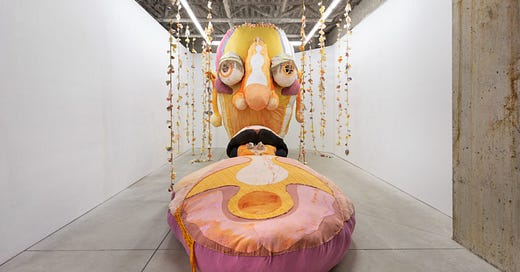I often get asked why I started @cdnartforecast. The answer is simple: I wanted to promote and support Canadian artists. I knew so many emerging artists who deserved more recognition than they were receiving and I thought a simple way to counter this was on Instagram. The account is a way to find new artists and appreciate art in the privacy of your palm. It strips art of the pretension and intimidation of the gallery setting and instead allows a more democratic approach.
During the pandemic, online art viewing was one of the few options we had. The physical gallery model becomes scarce when we’re not allowed inside public spaces. This isn’t to say brick-and-mortar art-viewing is irrelevant, just that we have had to shift our perspectives on looking. Can Instagram be a place of production, instead of simply reproduction? How do you buy art on Instagram? What does it mean to be an influencer? How many images can we really see in the span of a few minutes?
Instagram would have us believe that our brains are made for looking rapidly. I scroll through more than 20 images in seconds, only pausing when something stands out. In-person, when looking at art, I stare at a fraction of a canvas for the same amount of time, allowing my eye to adjust to what’s before it. Instagram, with its metrics and gamification, doesn’t encourage the same kind of close looking. Which is why I’ve always seen Instagram, and @cdnartforecast, as a step in a larger ecosystem of art-viewing. Instagram can be used to learn about new artists and become familiar with their work online, and with that part already done, when you see work in person you can really *look*.
This brings me to the present day. Art galleries are opening back up and I’ve been trying to catch as many shows as possible. Two things: I think the forced-hiatus may have been good for artists and art galleries—the shows up now feel fresh and more ambitious than ever—and I’m afraid I may have forgotten how to look. My eyes rapidly skirted over the art on the wall as if they were squares on Instagram.
Tau Lewis at Cooper Cole and Azadeh Elmizadeh at Franz Kaka broke me out of my lazy-looking, the work so intricate and encompassing that I got lost in it, I felt child-like again and stood still simply letting my eye wander while my body stayed still.
Final thoughts: If Instagram is the first-stop to learning about new artists and their processes, how can I build on that through a newsletter? Newsletters (and articles) allow a narrative to form around art in a useful way that’s near-impossible with the quickness that social media begets. I hope the newsletter leads to community forming, both in the comments and forums, but eventually in real life.
My end goal is lofty: An art ecosystem that doesn’t discredit one medium over another, but sees social media, newsletters, magazines, blogs, and galleries and museums, working together to build an art community.
Feel free to leave a comment on how Instagram has impacted your looking or general thoughts of what you’d like this newsletter to be.
~LINKS~
What We Mean When We Rant About Digital Art canadian art
A great conversation between Letticia Cosbert Miller and Emily Fitzpatrick on the potential—and shortfalls—of digital art.
Meet the New Innovators artnet
Featuring Vancouver’s Fazakas Gallery. “I like to remind people there is no homogenized Indigenous voice,” Fazakas says.
5 Things to Know About Collecting Figurative Paintings artsy
“Today a new cohort of Black, Indigenous, and people of color (BIPOC) and queer artists are producing bold figurative paintings that are not only exciting, but also reflective of the world around us.”
How Indigenous Filmmakers are Shaping the Future Cinema aperture
A recounting of the making, and importance, of Zacharias Kunuk’s 2001 film Atanarjuat.
Former Witte de With Announces Name Change artforum
“The name springs from a 1990 work, Canadian artist Ken Lum’s Melly Shum Hates Her Job, which is permanently installed on the building’s façade, and which has for years lent its name to the institution’s ground-floor gallery space.”
Stonecroft Foundation Visiting Artist Lecture Series: Ken Lum
The event takes place on November 12th at 6:00 pm ET on Zoom.
Amy Sillman: Faux Pas currently reading
Painter Amy Sillman’s writing is both easy to read and surprising, leading the reader to think about art in new ways.
$50 Kim Dorland Art Print in Support of ESN patelbrown gallery
This is a great deal! Buy a timed edition print by Kim Dorland to support the Encampment Support Network (ESN) of Toronto, ON. 100% of proceeds will be donated. Only until November 15th.
parting shot:







This is wonderful! Would love to see dialogue with emerging artists and how the pandemic may have shifted their practice, and/or how it may have altered what they are thinking about/their way of thinking.
I love everything you wrote here! Totally agree.